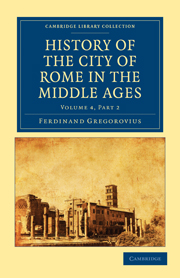CHAPTER IV
Published online by Cambridge University Press: 05 July 2011
Summary
The civic revolution, 1143
The installation of the Senate was the result no less of the already developed freedom of the Lombard cities, than of the peculiar conditions of Rome. From the eleventh century these cities had already acquired their autonomy under the shadow of the Church, which had previously held them in tutelage. The Ottos, and still more the emperors of the Salic house, had by degrees made over to the bishops the power of counts, and at the same time had bestowed many privileges on the cities. The cities gradually deprived the bishops of their jurisdiction, and became communes with their own magistrates. The citizens of strongly fortified towns made use of the struggle between Church and State, which not only weakened the bishoprics but also dissolved the union with the empire, to rise to the surface between the two enfeebled powers as a third and youthful force. In the beginning of the twelfth century the greater number of communes in Lombardy, Tuscany, the Romagna, and the Marches were governed by consuls annually elected, into whose hands the power formerly wielded by the count, as well as the larger part of the public revenues, had fallen.
- Type
- Chapter
- Information
- History of the City of Rome in the Middle Ages , pp. 453 - 523Publisher: Cambridge University PressPrint publication year: 2010First published in: 1896

